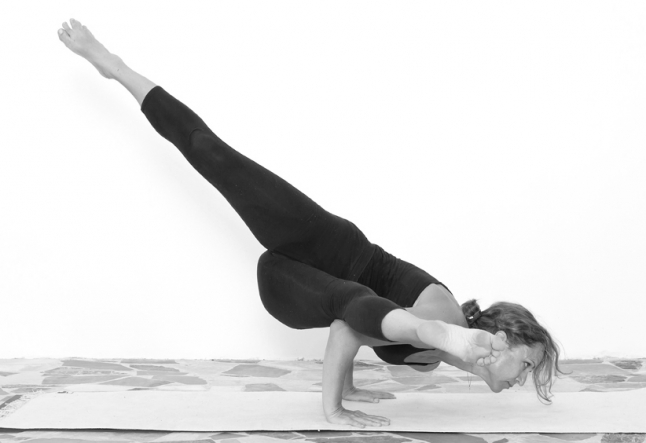an interview with andrea lutz

ashtanga yoga – letting the breath carry you through the practice
In the heart of Berlin, up on the Prenzlauer hill, there is Ashtanga Studio Berlin. Every morning between 7 and 10 AM, about 30 people pass through the studio to do their morning Mysore practice, assisted by two, sometimes three, teachers.
Andrea Lutz, the owner of the studio has more than 30 years of yoga practice and more than 20 of which she has dedicated exclusively to the Ashtanga Yoga method. The studio is now home to countless Ashtangis, and there is a nice community feeling to it. As you walk in, you see a quaint yoga library for use upon request, and many framed photos on the wall: of Guruji, of his teacher Tirumalai Krishnamacharya, of Manju Jois, and of Nancy Gilgoff.
Nancy is Andrea’s teacher, her inspiration, her mentor, her friend. It is her teachings that Andrea follows and passes on to others, and it is thus the direct teachings of Sri K. Pattabhi Jois as he taught Nancy and David Williams, some of his first American students who came to him back in the beginning of the ’70’s.
Anastasia Shevencho (AS): Knowing that you have been practicing yoga for more than 30 years, how did you first come into contact with yoga?
Andrea Lutz: I remember my first yoga class: I was 17 years old and had some problems with myself at this time [laughing]. So, I still remember when I came out of my first yoga class – something happened! Something inside myself opened, and I got interested in , to learn more about it, so I kept coming back.
AS: And how was the yoga scene different when you first started your practice? It was a long time ago…
Andrea Lutz: The yoga scene was very different back then because there were none of these yoga centers or big yoga schools. People around, even my parents, thought we were in some kind of a sect, or something [laughing]… yoga was something weird, for weirdos, definitely not like now, where everybody can do yoga mainstream – so it was a different thing!
AS: So how did you start with Ashtanga yoga specifically and what “hooked you”?
Andrea Lutz: When I started practicing yoga, I was practicing Sivananda yoga for many years, and then I did some years of Iyengar yoga, some hatha yoga general classes. I remember when a friend told me about this Ashtanga yoga teacher, she said: “We have to go there, this is Catharsis!” [laughing] So we went there: it was a small room, Mysore, there were only 12 people, but mat-to-mat, it was very small, very sweaty in there… and I thought: “wow, that’s different!” [laughing] … different from what I was used to in yoga. I liked it right away!
AS: How did you find your teacher Nancy?
Andrea Lutz: Actually the first, let’s say, 10-12 years of my practice I was only taught by men. I saw different teachers at this time, as I was looking for a teacher. I met Manju P. Jois, and was very inspired by him. He became my main teacher for many years and is still a big source of deep knowledge about Yoga. To be honest, the main reason I was going to meet Nancy, was the wish to learn Ashtanga Yoga with a woman, what is different than learning with a man. There were not that many women at this level, and this is actually how I met Nancy. I still remember my first class with her and it was… “love on the first sight” [laughing].
AS: How has this student-teacher relationship between Nancy and you developed over the years?
Andrea Lutz: I only had one class with her and I thought: “Ok, this is the woman I want to learn with”, and so I went right away one month to Maui [laughing]. I practiced with her, I stayed in her house, so this is how we became closer. Like every relationship over the years, it became closer, more familiar. And now that I could say that we’re kind of friends. I still respect her very highly as a teacher, and it’s different when we’re in the yoga room than when we’re private having a coffee together… The moment we’re in the room: she is the teacher, and I am the student, and this will stay like this.
AS: Yes, it seems important to preserve that kind of relationship.
Andrea Lutz: It is very important to have the roles clear. I have experienced this in my own teachings, it can cause problems in the teachings and in the friendship.
AS: Over the years that you have been practicing Ashtanga Yoga, which is more than 20 years now, how has your perception of the Ashtanga practice changed? In other words, what is important for you in this practice now and how was it different before?
Andrea Lutz: At one point after I started, the practice became too physical. And this is still one of the major problems with Ashtanga yoga: the asanas are becoming too important. Which asanas you practice up to, or you’re allowed to do this, but not allowed to do that. After I met Manju Jois and started learning from him, this changed. Manju cares about the practice itself and how you breathe into it, how much you are dedicated to Yoga in all of its aspects.
This really influenced my own view of the practice: [it is] very traditional in the sequence and very much into the breath. The asana doesn’t have to be “perfect”, it is still the same asana and becomes the asana through your breath and your concentration, not through flexibility or something [like physical strength]. What makes the yoga is the concentration and breathing, something you cannot see easily from the outside. I always say: “you can better hear than see how advanced someone is in the practice”.
AS: What would you say is the essence of Ashtanga yoga as taught by Nancy? How does she teach differently from others?
Andrea Lutz: Nancy is able to see the energetic flows of the body, and she has this amazing ability to locate them and help you release the blockages. She is one of very few teachers still teaching the “old style” of Ashtanga Yoga, as was taught to her directly from Sri K. Patthabi Jois. Her mission is to keep this teaching alive, in a time where everything changes so fast. She travels the world teaching extensively people the “pure” method of Ashtanga Yoga. This is what she believes in.
This is my experience with Nancy and sure, other teachers teach from a different point of view – that’s great because that’s their point of view. Any teacher can only teach from the point of view where they are and how they see the practice. And every student finds the teacher to whom they connect most. In any case, it’s great to have diversity: there are many amazing teachers in this world that you can learn from!
AS: I remember once I understood you saying something along the lines that it was important to try different ways, and then stick with the way that resonates the most with you.
Andrea Lutz: Well, you don’t have to… I have some students who have never been to a different yoga school. They came – they liked it, they stayed – and they love it. No problem. I wouldn’t tell them: “You have to go see other things.” Why? If they are happy? Why go?
But what I do see is that in the yoga scene there is a lot of confusion, and a lot of people are seeing many different teachers at the same time, and I think this can cause some problems. If you’re into the practice, at a certain point you have to make a decision to a certain lineage, or to a certain line of teachers and stick with it. There are different ways, and they all work. The only thing that doesn’t work if you’re mixing too much. I would never say that what we teach is the only way that works, there are other ways, fantastic ways, but you have to make a decision! It is a personal choice. What resonates with one yogi may not resonate with another.
AS: It seems that the new generation of Ashtangis, maybe because of the immense popularity of the method, and the enormous amount of practitioners who practice Ashtanga yoga now, are put within a certain system with very specific strict and rigid rules and regulations. How do you feel about that?
Andrea Lutz: I mean, you just answered it in a way: it’s out of necessity… when you have a lot of people… The way we teach, well you know, as you come to class, when we have more than 12-15 people we have two teachers, a lot of times we have classes with 3 people teaching as I take assistants in, so it’s quite intense… So I think in the Mysore setting you cannot really see more than 12-15 people and work with them individually, unless of course you know all of them well, so maybe you can go up to 20. Now that Ashtanga yoga is so popular and the classes are so big, the only way you can manage is to put up strict rules to keep the people in line.
AS: What do you think is the future of this method? With Pattabhi Jois gone, and with the senior students of Pattabhi Jois getting older and maybe not teaching as much anymore, with the Mysore booming with people, what do you think are going to be the future developments of the method?
Andrea Lutz: Even if you say that the senior teachers would not teach anymore, we don’t know. I mean, Nancy is 68, Tim Miller is 65, they can teach another 20 years, I hope so [laughing]. But they also have very strong students who could keep up this method. Nancy has a very strong group of students around her, and so does Tim and I hope they will continue this line.
Anyways, yoga was never really mainstream, and now it gets mainstream. So what’s happening now? When you have something mainstream, there is always a room for some “subculture”… So this method what we have from the senior teachers, the Pattabhi Jois teachings, it will continue, but it will not be mainstream.
AS: To finish, what kind of advice would you give to someone new on the Ashtanga path?
Andrea Lutz: What I always say when someone new comes to class is that, first, it’s important to start slowly, to build it up over time. I still like to teach the old method, starting with the sun salutation A and then slowly continue it until they build up the whole sequence, but it takes a while … I think it is important that the whole system, the mind, the different bodies [koshas] can grow into it.
Second, practice regularly: make a commitment. Even if it’s just 20 minutes and you just do some sun salutations and the last 3 finishing postures, do this every day, 5-6 times a week, no moon days, for women – not during their period. So just these 20 minutes is a great step to make the commitment to the practice. Build it up slowly and commit to it.
Read next >> why your shoulders matter – exploring the shoulder girdle in ustrasana








